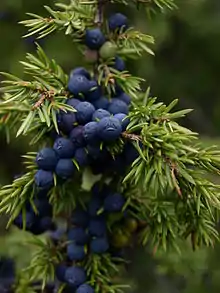Juniperites
See also: juniperites
Translingual

The leaves and berries of a common juniper (Juniperus communis) in Estonia. The common juniper is the type species of juniper, which is thought to be related to extinct plants of the Juniperites genus.
Alternative forms
- juniperites (rare)
Etymology
From Late Latin Juniperītēs, from jūniperus (alternative form of iūniperus (“juniper-tree”)) + -ītēs (“-ite, suffix meaning ‘those belonging to’”).
Pronunciation
- (Received Pronunciation) IPA(key): /ˌdʒuːnɪpəˈɹaɪtiːs/
- (General American) IPA(key): /ˌdʒunɪpəˈɹaɪtis/
- Hyphenation: Ju‧ni‧per‧i‧tes
Proper noun
Juniperites f, m
- (obsolete) A taxonomic genus within the class Coniferae – extinct fossil plants resembling the juniper.
- 1835, Adam Sedgwick; Roderick Impey Murchison, quoting Adolphe-Théodore Brongniart, “XVIII.—A Sketch of the Structure of the Eastern Alps; with Sections through the Newer Formations on the Northern Flanks of the Chain, and through the Tertiary Deposits of Styria, &c. &c. [...] With Supplementary Observations, Sections, and a Map”, in Transactions of the Geological Society of London (2nd Series), volume III (in English), London: Printed by Richard Taylor, Red Lion Court, Fleet Street. Sold at the apartments of the Geological Society, Somerset House, OCLC 65182841, page 373:
- After an examination of all the specimens, I am still in doubt as to the greater number of them; for, either from their being too incomplete, or from not having made a sufficient number of comparisons, I am unable to arrive at very precise results. They appear to me to belong to eleven species. / 1. Juniperites subulata. The form and the insertion of the leaves appear to me to indicate a Juniperus, allied to, though distinct from, that found in the lignite formations of Bohemia, which I have named in my "Prodromus" Juniperites acutifolia. I possess specimens from the freshwater formation of Armissau near Narbonne, apparently of the same species.
- [1849, John Craig, “Juniperites”, in A New Universal Etymological, Technological, and Pronouncing Dictionary of the English Language, Embracing All the Terms Used in Art, Science, and Literature, volume II (Jac–Zyt) (in English), London: Published (for the proprietors,) by Henry George Collins, 22 Paternoster Row, OCLC 3119134, page 15:
- Juniperites, ju-ne-per-i′tis, s[ubstantive]. A genus of fossil plants, in which the branches are ranged irregularly; leaves short, obtuse, inserted by a broad base, opposite, decussate, and arranged in four rows.]
- 1851, G. F. Richardson; Thomas Wright, “Fossil Botany”, in An Introduction to Geology, and Its Associate Sciences, Mineralogy, Fossil Biology, and Palæontology (in English), new, rev. and considerably enl. edition, London: H[enry] G[eorge] Bohn, York Street, Covent Garden, OCLC 948023952, page 171:
- When the leaves and small and densely imbricated, they are generally considered to belong either to lycopodiaceæ or coniferæ; but there is so little to distinguish these families in a fossil state, that there is scarcely any means of demonstrating to which of these such genera as lycopodites, lycopodendron, juniperites, taxites, &c., and the like, actually belong.
- [1859, David Page, “General Terms and Technicalities”, in Handbook of Geological Terms and Geology (in English), Edinburgh; London: William Blackwood and Sons, OCLC 9124487, page 219:
- Juniperítes (Lat. juniperus, the juniper tree).—The generic term for such fossil coniferæ as are evidently allied to the juniper. Several species occur in tertiary lignites, and are known by their short, obtuse, broad-based leaves, arranged in four opposite rows round irregularly-forking branches.]
- 1862, John Hutton Balfour, “Reign of Angiosperms”, in Outlines of Botany: Designed for Schools and Colleges (in English), 2nd edition, Edinburgh: Adam and Charles Black, North Bridge, page 669:
- The Eocene epoch in general is characterized by the predominance of Algæ and marine Naiadaceæ, such as Caulinites and Zosterites; by numerous Coniferæ, the greater part resembling existing genera among the Cupressineæ, and appearing in the form of Juniperites, Thuites, Cupressites, Callitrites, Frenelites, and Solenostrobus; […]
- 1970, Henry N[athaniel] Andrews, Jr., “Generic Index of Fossil Plants”, in Index of Generic Names of Fossil Plants, 1820–1965: Based on the Compendium Index of Paleobotany of the U.S. Geological Survey (Geological Survey Bulletin; 1300) (in English), Washington, D.C.: United States Government Printing Office, OCLC 770588386, page 110:
- JUNIPERITES Adolphe[-Théodore] Brongniart, 1828. Juniperites alienus (Sternberg) Adolphe Brongniart, 1828b, p. 108.
-
Usage notes
The word juniperite, defined in The Century Dictionary (1889–1891) as “[a] petrified trunk or fossil impression belonging to the genus Juniperus or Juniperites”,[1] which is itself cited by the Oxford English Dictionary, does not appear to be attested in English.
Hypernyms
- Plantae – kingdom; Spermatophyta – phylum; Pinophyta or Coniferae – division
Related terms
References
- William Dwight Whitney, editor (1889–1891), “juniperite”, in The Century Dictionary: An Encyclopedic Lexicon of the English Language, volume III, part IX (Ihleite–Juno), New York, N.Y.: The Century Co., OCLC 810818109, page 3254: “juniperite (jö′ni-pėr-īt), n. [< N[ew] L[atin] Juniperites] A petrified trunk or fossil impression belonging to the genus Juniperus or Juniperites.”
Further reading
This article is issued from Wiktionary. The text is licensed under Creative Commons - Attribution - Sharealike. Additional terms may apply for the media files.